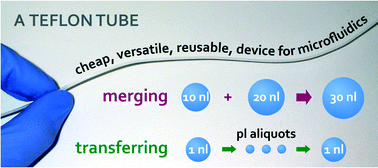Merging drops in a Teflon tube, and transferring fluid between them, illustrated by protein crystallization and drug screening†
Abstract
The ability to manipulate drops with small volumes has many practical applications. Current microfluidic devices generally exploit channel geometry and/or active external equipment to control drops. Here we use a Teflon tube attached to a syringe pump and exploit the properties of interfaces between three immiscible liquids to create particular fluidic architectures. We then go on to merge any number of drops (with volumes of micro- to nano-liters) at predefined points in time and space in the tube; for example, 51 drops were merged in a defined order to yield one large drop. Using a different architecture, specified amounts of fluid were transferred between 2 nl drops at specified rates; for example, 2.5 pl aliquots were transferred (at rates of ~500 fl s−1) between two drops through inter-connecting nano-channels (width ~40 nm). One proof-of-principle experiment involved screening conditions required to crystallize a protein (using a concentration gradient created using such nano-channels). Another demonstrated biocompatibility; drugs were mixed with human cells grown in suspension or on surfaces, and the treated cells responded like those grown conventionally. Although most experiments were performed manually, moderate high-throughput potential was demonstrated by mixing ~1000 different pairs of 50 nl drops in ~15 min using a robot. We suggest this reusable, low-cost, and versatile methodology could facilitate the introduction of microfluidics into workflows of many experimental laboratories.


 Please wait while we load your content...
Please wait while we load your content...